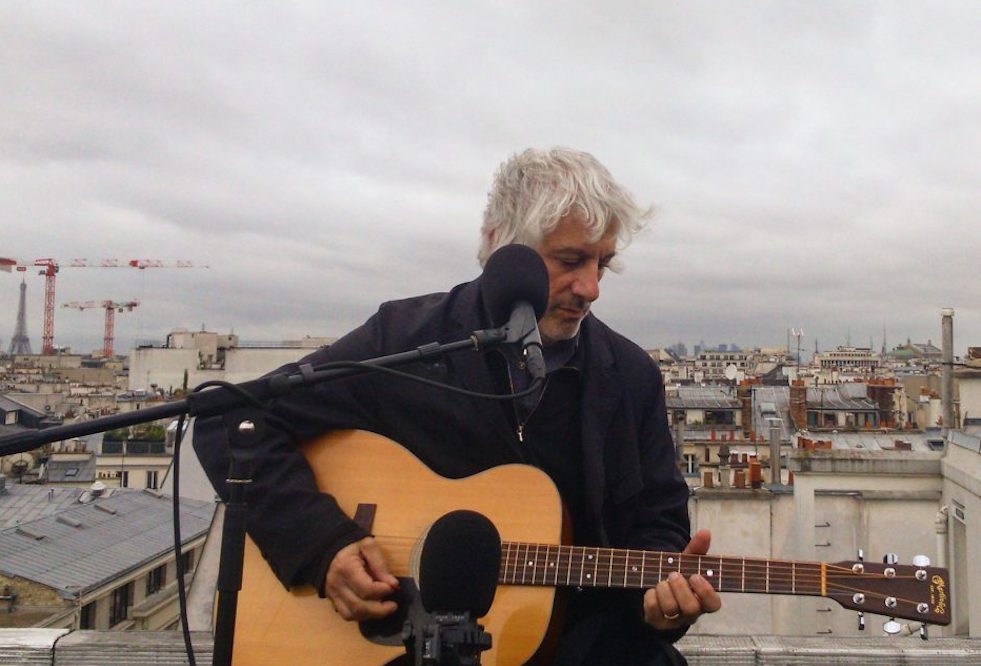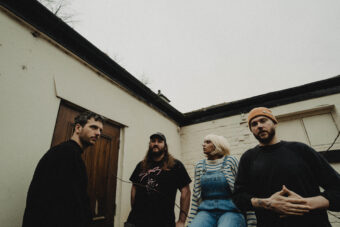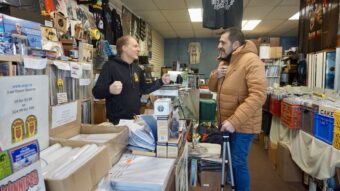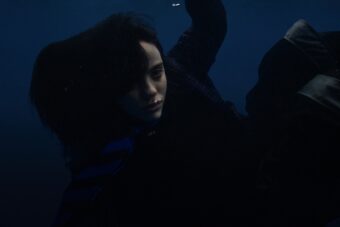Lee Ranaldo spent three decades playing guitar in Sonic Youth, as well as playing something of a George Harrison role in the band: the third most prominent singer/songwriter in the group who tended to have one or two excellent songs like “Eric’s Trip” or “Mote” on each album.
In 2012, Ranaldo and bandmate Thurston Moore shared the No. 1 spot on SPIN’s 100 Greatest Guitarists of All Time list. But he’s also a prolific solo artist and writer in his own right, with dozens of solo and collaborative releases to his name, along with several nonfiction and poetry books. His albums have ranged from noise experiments and improvised sets with jazz musicians to spoken word and singer-songwriter introspection, with much of his best and most accessible work since Sonic Youth began an indefinite (and likely permanent) hiatus in 2011.
On Feb. 21, Mute will release Names of North End Women, the first collaborative album by Ranaldo and Raul Refree, a versatile Spanish musician who previously produced 2016’s Acoustic Dust and 2017’s Electric Trim for Ranaldo. It’s one of the best, most unique and forward-thinking albums in Ranaldo’s estimable career. It pairs his sung and spoken vocals (and lyrical contributions from author Jonathan Lethem) with an unpredictable array of loops and tones, and surprisingly, little guitar. Here’s a chronological overview of the 10 best records Ranaldo has released outside Sonic Youth over the course of his decades-long career:
Lee Ranaldo – From Here To Infinity (SST, 1987)
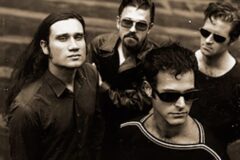
Also Read
30 Overlooked 1994 Albums Turning 30
Lock grooves, which can loop a couple of seconds of sound at the end of a side of vinyl, have been a popular novelty since The Beatles and The Who featured them on albums in 1967. <EVOL, Sonic Youth’s 1986 album for the legendary SST label, featured Ranaldo’s first lead vocal turn on “In the Kingdom #19” and ended with a lock groove on “Expressway to Yr Skull.” A year later, SST released Ranaldo’s inventive solo record, From Here To Infinity, a collection of short instrumentals that all ended in lock grooves. The CD edition of the album features longer versions of each track ending with loops to simulate the lock groove experience.
Lee Ranaldo – Scriptures of the Golden Eternity (Father Yod, 1993)
Lee Ranaldo’s 1993 album was named after Jack Kerouac’s 1960 poetry collection The Scripture of the Golden Eternity, and contains guitar improvisations and tape loops recorded live at solo shows in New York City in the late ‘80s, as well as some of Ranaldo’s most Beat Generation-inspired spoken word. “When I got to college I read On The Road and my interest was just really focused on his work for a while and it has been ever since,” Ranaldo told MTV in 1997 when he released the tribute compilation Kerouac: Kicks Joy Darkness. The first and longest of Golden Eternity’s three tracks, “One,” features lines that made their way into Daydream Nation’s “Eric’s Trip,” which Sonic Youth was recording at the time. It also gives the Superman-inspired backstory for the name of both the 1985 Sonic Youth track “Echo Canyon” and the Echo Canyon studio the band would go on to build in 1996.
Lee Ranaldo & William Hooker – Envisioning (Knitting Factory Works, 1995)
Lee Ranaldo and free jazz drummer William Hooker recorded several albums together, sometimes as a duo and other times outside musicians including Zeena Parkins and Christian Marclay. The duo’s first album, Envisioning, was recorded at a Knitting Factory in New York City performance on April 8, 1994, hours after Kurt Cobain’s body was found. “Matches” opens with Ranaldo shrugging “I’m not much good at mass” before beginning an increasingly intense spoken-word piece, never addressing mentioning Cobain by name but noting, “He was someone I counted as a friend,” as he paralleled the day’s media frenzy with newspaper headlines about the JFK assassination.
Lee Ranaldo – East Jesus: Some Recordings 1981-1991 (Atavistic, 1995)
East Jesus was a compilation that collected pieces that, aside from some excerpts of From Here To Eternity, had never appeared on an album, including 7” singles and unreleased tracks. The opening track “The Bridge” is perhaps Ranaldo’s best piece uniting poetry and music, as he tells a story of crossing the Brooklyn Bridge with a truck full of furniture and using his guitar to simulate the unnerving sounds made by the heavy truck driving over the bridge’s metal slats. And “Walker Groves” was recorded live at the 1981 New York Noise Fest, an auspicious night where Thurston Moore and Kim Gordon played their first show as Sonic Youth, were impressed by Ranaldo and invited him to join the band.
Lee Ranaldo – Amarillo Ramp (For Robert Smithson) (1998)
In just five tracks, Amarillo Ramp manages to encompass nearly the full range of Lee Ranaldo’s solo work, something of a sampler of styles. The lengthy title track, a tribute to Land Art pioneer Robert Smithson, is an abstract noise piece, followed by “Non-Site #3,” a jam session with other members of Sonic Youth, and the spoken word piece “Notebook.” “Here” is a beautiful folky guitar instrumental full of melodic twists and turns, and the album closes with a cathartic cover of John Lennon’s “Isolation.”
Lee Ranaldo – Maelstrom From Drift (Three Lobed, 2008)
Much of Lee Ranaldo’s solo work suggests that his interest in collage and juxtaposition extends to making albums out of a patchwork of different sessions. And never is that more evident than on Malestrom From Drift, an entry in Three Lobed Records’ subscription CD series Oscillation III. The album’s nine tracks were recorded in mostly different studios in different years. There’s a song with his longtime partner and collaborator Leah Singer and a song by Glacial, Ranaldo’s trio with David Watson and Tony Buck that would eventually release an album of its own in 2012. The ambient field recording “Navel Milk Prison” was taped in 1994, while the 2007 piano piece “The Homeless Hairdresser” was mixed together with crowd noise recorded in 2003.
Lee Ranaldo – Between the Times and the Tides (Matador, 2012)
If Lee Ranaldo was indeed the Harrison of Sonic Youth, then Between the Times and the Tides, released less than six months after the band’s probably permanent hiatus, was his All Things Must Pass of sorts. It was at the time the largest collection of full-on songs – no instrumental soundscapes or spoken word pieces — written and sung by Ranaldo. And on songs like the haunting, ominous “Xtina As I Knew Her,” Ranaldo was backed by an all-star cast that included two Sonic Youth drummers (Steve Shelley and Bob Bert), keyboardist John Medeski, and Wilco guitarist Nels Cline.
Lee Ranaldo and the Dust – Last Night on Earth (Matador, 2013)
Ranaldo recorded Last Night on Earth with many of the same players as the previous year’s Between the Times and the Tides. But it marked the first time that he christened a band name, The Dust, for his core backing trio of Steve Shelley, Alan Licht, and Tim Luntzel. And the band gelled beautifully on Last Night On Earth’s extended jams like the nine-minute “Rising Tide,” evoking Sonic Youth’s late-period masterpiece Murray Street.
Lee Ranaldo – Electric Trim (Mute, 2017)
Electric Trim is, in retrospect, a point of transition. It features uptempo guitar-driven numbers with many of the same backing musicians from Ranaldo’s two previous Matador albums. It was produced by Renfree and subtly incorporates some of the looped and programmed sounds that would dominate their later collaboration. The result is an intriguing and unpredictable mesh of styles that includes the standout Sharon Van Etten duet “Last Looks.”
Lee Ranaldo & Raul Renfree – Names of North End Women (Mute, 2020)
Names of North End Women is a stark and stirring record where Ranaldo blends his melodic vocals with his staccato spoken-word delivery more seamlessly than ever before, with occasional harmonies from Renfree. But the music is the real breakthrough, marrying the sound of Ranaldo’s early lock grooves and tape loops to Renfree’s more modern style of beat-making. “Words Out of the Haze” rides an ominous bass pulse that threatens to sound like dance music before an acoustic flamenco guitar and a screeching electric guitar come in and completely alter the sound of the track. And the elegiac “The Art of Losing” is one of Ranaldo’s best classic rock ballads dressed up in a twitchy kick drum pattern and a climactic burst of violin.

